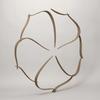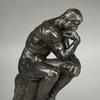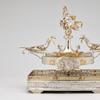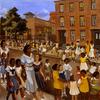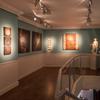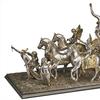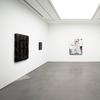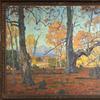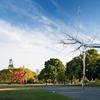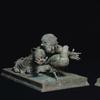Whitney to Debut 'Stuart Davis: In Full Swing' on June 10
- NEW YORK, New York
- /
- April 25, 2016
Debuting at the Whitney on June 10, 2016, Stuart Davis: In Full Swing features approximately 100 artworks by an artist whose formal brilliance and complexity captured the energy of mass culture and modern life. The exhibition is unusual in its focus on Stuart Davis’s mature work, from his paintings of consumer products of the early 1920s to the work left on his easel at his death in 1964, and in exploring Davis’s habit of using preexisting motifs as springboards for new compositions.
Co-organized by the Whitney Museum of American Art and the National Gallery of Art in Washington, DC, the exhibition will be on view at the Whitney from June 10 through September 25, 2016, and at the National Gallery of Art from November 20, 2016 through March 5, 2017. It will subsequently travel to the De Young Museum in San Francisco from April 8 through August 6, 2017, and to Crystal Bridges Museum of American Art in Bentonville, Arkansas, from September 16, 2017 through January 8, 2018.
Stuart Davis: In Full Swing departs in significant ways from earlier presentations of the artist’s work. The exhibition omits Davis’s decade of apprenticeship to European modernism (following his introduction to it at the 1913 Armory Show) in favor of the series of breakthroughs he made beginning in 1921 with his paintings of tobacco packages and household products, and continuing into his last two decades in which he employed abstract shapes, brilliant color, and words to evoke the ebullience of popular culture.
Stuart Davis: In Full Swing is co-organized by Barbara Haskell, Curator, Whitney Museum of American Art, New York, and Harry Cooper, Curator and Head of Modern Art, National Gallery of Art, Washington, DC, with Sarah Humphreville, Curatorial Assistant, Whitney Museum of American Art, New York.
“Stuart Davis has been called one of the greatest painters of the twentieth century and the best American artist of his generation, his art hailed as a precursor of the rival styles of pop and geometric color abstraction,” remarks Barbara Haskell. “Faced with the choice early in his career between realism and pure abstraction, he invented a vocabulary that harnessed the grammar of abstraction to the speed and simultaneity of modern America. By merging the bold, hard-edged style of advertising with the conventions of avant-garde painting, he created an art endowed with the vitality and dynamic rhythms that he saw as uniquely modern and American. In the process, Davis achieved a rare synthesis: an art that is resolutely abstract yet at the same time exudes the spirit of popular culture."
“A world citizen always searching for the abstract in the concrete, always transmuting the particular rhythms of American life into the universal experience of art, Davis was an American original,” note Adam D. Weinberg, Alice Pratt Brown Director of the Whitney Museum, and Earl A. Powell III, Director of the National Gallery of Art. “It would be hard to think of a better artist to be jointly presented by the Whitney Museum of American Art and the National Gallery of Art—two institutions that, despite our differences in scope and mission, share a dedication to the art of this country across media and over the generations.”
Stuart Davis was born in Philadelphia, Pennsylvania, on December 7, 1892, the son of artists. His lifelong belief that art should provide insight into life's experiences had its origin in his childhood exposure to the city's newspaper illustrators in his father's circle who would form the core of Ashcan realism and to his later studies with the leader of that circle, Robert Henri, whose art school he entered in 1909 after his freshman year in high school. For four years, Davis emulated the urban realism promoted by Henri, becoming a rising star within his mentor's circle of students.
Seeing the legendary 1913 Armory Show was revelatory for Davis, leading him to decide to become a modern artist. He later admitted it “took him an awful long time.” Between 1913 and the mid-1920s, he assimilated the lessons of European modernism, particularly Fauvism and Cubism. In 1927 came his series of so-called egg beater paintings—geometric still lifes in which he reduced the forms of a rubber glove, electric fan, and an eggbeater to flat, geometric planes set at angles to one another. The paintings’ absence of recognizable subject matter and Cubist vocabulary were radical for an American artist, thrusting Davis into a leadership position within the nation’s avant-garde.
Davis enjoyed a close relationship with the Whitney Museum throughout his life. He was a founding member of the Whitney Studio Club in 1918 and had his first one-man exhibition there in 1926. In 1927 Gertrude Vanderbilt Whitney gave him a year-long stipend which allowed him to focus on his art without interruption and led to his egg beater paintings. Following his inclusion in 1928 in the Whitney Studio Club Annual, Mrs. Whitney purchased two of his paintings to finance a trip for him to Paris. While there, he solidified his commitment to reducing form to flat planes of color by depicting the city’s streets with the same abstract geometric vocabulary he had introduced in his egg beater paintings. When Davis returned to New York from Paris in 1929, he gifted Mrs. Whitney two paintings in thanks for her support. Over the years, the Whitney continued to show and purchase Davis’s work. Twenty-seven pieces, dating from 1913 to 1964, are part of the Whitney’s permanent collection.
During the 1930s, Davis immersed himself in political activism on behalf of artists’ economic rights and freedom of expression. Between 1934 and 1940, he served as a leading member of the Unemployed Artists Group and the Artists’ Committee of Action, vice president of the Artists Union, editor of the left-wing journal Art Front and vice president and ultimately president of the American Artists’ Congress. Combined with his prolific writings, his activism left little time for painting. His primary aesthetic output during this period was murals in which he announced a new vocabulary of overlapped, flat planes of vibrant color whose visually dynamic tempos echo the syncopation and polyrhythms of modern life.
Davis’s working method changed in 1940 following his resignation from the American Artists’ Congress and his retreat from political activism. From that date on, he typically used preexisting compositions as springboards for new paintings, rarely making a painting that did not make reference, however hidden, to an earlier work. He likened this recycling of motifs to jazz improvisations, explaining that “it’s the same thing as when a musician takes a sequence of notes and makes many variations on them.”
Until the mid-1940s, Davis’s art and advocacy of vanguard aesthetic principles were at odds with the prevailing taste in America for realist art. Critically acclaimed and revered by fellow artists, he nevertheless struggled financially. This changed as abstraction began to find acceptance in the New York art world and Davis’s stature as a leading American modernist solidified, with several American museums presenting one-man shows of his work during the decade, including the Museum of Modern Art, New York (1945) and the Baltimore Museum of Art (1946).
Davis’s work entered a new phase in 1950 as he expanded the scale of his shapes and limited the number of colors he used. The resulting paintings featured clearly defined, assertive planes of brilliant color that visually seemed to move forward and backward at enormous speed. Combined with the words he began to incorporate into his art in 1950, these fast-moving color planes exude the bold energy and ebullience of advertising and popular culture.
With these works, Davis became a dominant force in postwar art. In 1952, he was one of four artists to represent the United States at the Venice Biennale; that same year, he received a Guggenheim Foundation Fellowship and a mural commission from Drake University. In 1957, the Walker Art Center, Minneapolis, organized a retrospective of his work that traveled to the Whitney, the San Francisco Museum of Art, and the Des Moines Art Center. He was awarded the Solomon R. Guggenheim Museum International Award in both 1958 and 1960.
Davis died of a heart attack on June 24, 1964 in New York at the age of seventy-one. A memorial exhibition of 127 of his works, organized by the National Collection of Fine Arts, Smithsonian Institution, traveled to the Whitney in 1965.
The exhibition is accompanied by a fully illustrated scholarly catalogue, published by the Whitney Museum of American Art, The National Gallery of Art, and Prestel Publishing. The book includes essays by the exhibition’s organizers, Barbara Haskell, Curator, Whitney Museum of American Art, New York, and Harry Cooper, Curator and Head of Modern Art, National Gallery of Art, Washington, DC; and a foreword by Adam D. Weinberg, Alice Pratt Brown Director, Whitney Museum of American Art, New York; and Earl A. Powell III, Director, National Gallery of Art. Included also is a detailed narrative chronology, which draws on previously unpublished sources and incorporates much of Davis’s writing. In combination with the book’s essays and foreword, the chronology paints a vivid picture of economic hardship, political activism, personal struggle, and eventual triumph, bringing to life an artist who assimilated Cubism, popular culture, advertising, and jazz to create works whose jagged shapes, brilliant color, and calligraphic spontaneity exude the energy of the American urban experience.


